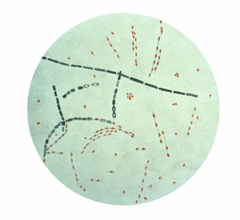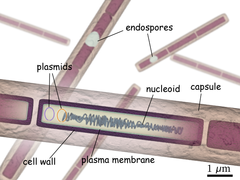Bacillus anthracis
| Bacillus anthracis | |
|---|---|
 |
|
| Photomicrograph of Bacillus anthracis (fuchsin-methylene blue spore stain). | |
| Scientific classification | |
| Kingdom: | Bacteria |
| Phylum: | Firmicutes |
| Class: | Bacilli |
| Order: | Bacillales |
| Family: | Bacillaceae |
| Genus: | Bacillus |
| Species: | B. anthracis |
| Binomial name | |
| Bacillus anthracis Cohn 1872 |
|

Bacillus anthracis is a Gram-positive spore-forming, rod-shaped bacterium, with a width of 1-1.2µm and a length of 3-5µm. It can be grown in an ordinary nutrient medium under aerobic or anaerobic conditions[1]. It is the only bacterium known to synthesize a protein capsule (D-glutamate), and the only pathogenic bacterium to carry its own adenylyl cyclase virulence factor (edema factor). It bears close genotypical and phenotypical resemblance to Bacillus cereus and Bacillus thuringiensis. All three species share cellular dimensions and morphology. All form oval spores located centrally in a non-swollen sporangium. Bacillus anthracis spores in particular are highly resilient, surviving extremes of temperature, low-nutrient environments, and harsh chemical treatment over decades or centuries.
Contents |
Historical background
Casimir Davaine demonstrated that the symptoms of anthrax were invariably accompanied by the microbe B. anthracis.[2] B. anthracis was the first bacterium conclusively demonstrated to cause disease, by Robert Koch in 1876.[3] The species name anthracis is from the Greek anthrakis (ἄνθραξ), meaning coal and referring to the most common form of the disease, cutaneous anthrax, in which large black skin lesions are formed.
Pathogenesis
Three forms of anthrax disease are recognized based on their form of inoculation.
- Cutaneous
- the most common form (95%), causes a localized inflammatory black necrotic lesion (eschar)
- Pulmonary
- highly fatal and characterized by sudden massive chest edema followed by cardiovascular shock
- Gastrointestinal
- rare but also fatal (causes death to 25%) type results from ingestion of spores
Treatment
Infections with B. anthracis can be treated with β-lactam antibiotics such as penicillin, and others which are active against Gram-positive bacteria.[4]
Laboratory research
Components of tea, such as polyphenols, have the ability to inhibit the activity both of Bacillus anthracis and its toxin considerably; spores, however, are not affected. The addition of milk to the tea completely inhibits its antibacterial activity against anthrax[5]. Activity against the B. athracis in the laboratory does not prove that drinking tea affects the course of an infection, since it is unknown how these polyphenols are absorbed and distributed within the body.
Host Interactions
As with other pathogenic bacteria, B. anthracis must acquire iron in order to grow and proliferate in its host environment. The most readily available iron sources for pathogenic bacteria are the heme groups used by the host in the transport of oxygen. In order to scavenge heme from host hemoglobin and myoglobin, B. anthracis uses two secretory siderophore proteins, IsdX1 and IsdX2. These proteins can separate heme from hemoglobin, allowing surface proteins of B. anthracis to transport it into the cell.[6]
External links
- Bacillus anthracis genomes and related information at PATRIC, a Bioinformatics Resource Center funded by NIAID
- Hazards in Animal Research Database - Bacillus anthracis
- Pathema-Bacillus Resource
References
- ↑ Holt, J. G., N. R. Krieg, P. H. A. Sneath, J. T. Staley, and S. T. Williams. 1994. Group 17: gram-positive cocci, p. 527-558. In W. R. Hensyl (ed.), Bergey's manual of determinative bacteriology, 9th ed. Williams and Wilkins, Baltimore, Md.
- ↑ Théodoridès, J (April 1966). "[http://www.ncbi.nlm.nih.gov/pmc/articles/PMC1033586/pdf/medhist00151-0053.pdf Casimir Davaine (1812-1882): a precursor of Pasteur"]. Medical history 10 (2): 155–65. PMID 5325873.
- ↑ Koch, R. (1876) "Untersuchungen über Bakterien: V. Die Ätiologie der Milzbrand-Krankheit, begründet auf die Entwicklungsgeschichte des Bacillus anthracis" (Investigations into bacteria: V. The etiology of anthrax, based on the ontogenesis of Bacillus anthracis), Cohns Beitrage zur Biologie der Pflanzen, vol. 2, no. 2, pages 277-310.
- ↑ Barnes JM (1947). "Penicillin and B. anthracis.". J Path Bacteriol 194: 113. doi:10.1002/path.1700590113.
- ↑ "Anthrax and tea". Society for Applied Microbiology. 2008-03-17. http://www.sfam.org.uk/newsarticle.php?214&2. Retrieved 2008-08-13.
- ↑ Maresso AW, Garufi G, Schneewind O (2008). "Bacillus anthracis Secretes Proteins That Mediate Heme Acquisition from Hemoglobin.". PLOS Pathogens 4(8): e1000132.
|
||||||||||||||||||||||||||||||||||||||||||||||||||||||||